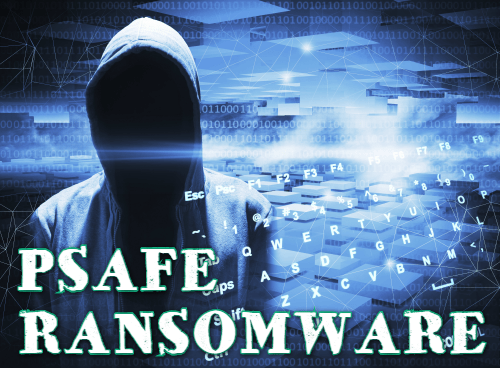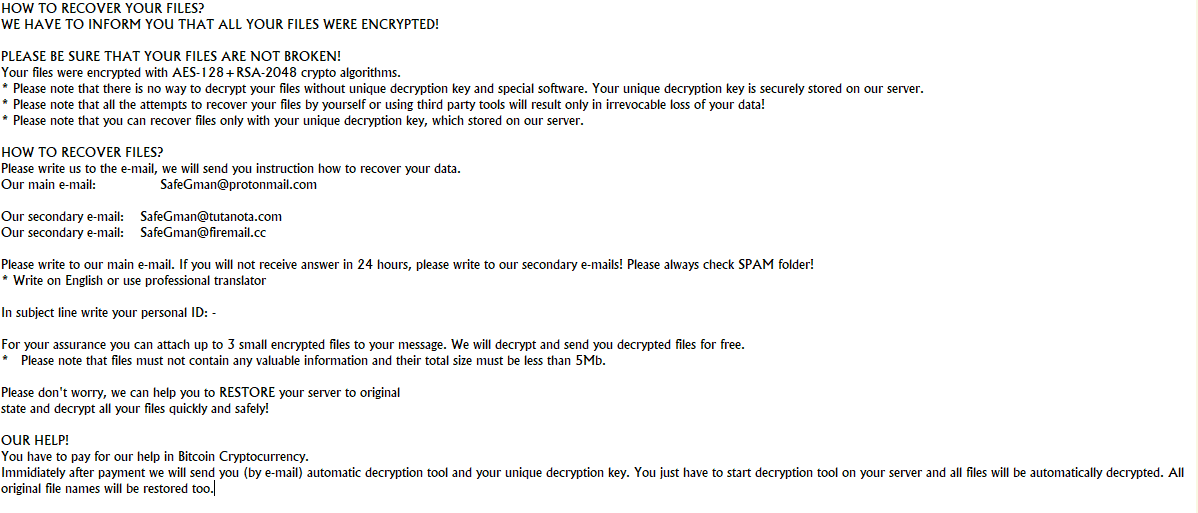What is PSAFE Ransomware
PSAFE ransomware is another ransomware that comes to the PC without the consent of the user and encrypts user data using a multi-stage algorithm. As a rule, PSAFE ransomware touches precisely the category of files that is most significant for users, including photos, videos, archives, MS Office documents, and so on. Among other things, PSAFE ransomware deletes shadow copies of files and system restore points to prevent users from recovering data using standard utilities and system services.

PSAFE ransomware uses the AES-128+RSA-2048 algorithm for encryption. It also changes the file extensions to .PSAFE, which makes them permanently inoperative and unsuitable for further use. Genealogically, PSAFE ransomware belongs to the Matrix cryptovirus family. Activity PSAFE ransomware occurred at the beginning of February 2020, and in just a few days PSAFE ransomware spread throughout the world. Also, PSAFE ransomware creates the #PSAFE_README#.rtf text document that contains information about encryption and ransom methods. Here is the file:

HOW TO RECOVER YOUR FILES?
WE HAVE TO INFORM YOU THAT ALL YOUR FILES WERE ENCRYPTED!PLEASE BE SURE THAT YOUR FILES ARE NOT BROKEN!
Your files were encrypted with AES-128+RSA-2048 crypto algorithms.
* Please note that there is no way to decrypt your files without unique decryption key and special software. Your unique decryption key is securely stored on our server.
* Please note that all the attempts to recover your files by yourself or using third party tools will result only in irrevocable loss of your data!
* Please note that you can recover files only with your unique decryption key, which stored on our server.HOW TO RECOVER FILES?
Please write us to the e-mail, we will send you instruction how to recover your data.
Our main e-mail: SafeGman@protonmail.comOur secondary e-mail: SafeGman@tutanota.com
Our secondary e-mail: SafeGman@firemail.ccPlease write to our main e-mail. If you will not receive answer in 24 hours, please write to our secondary e-mails! Please always check SPAM folder!
* Write on English or use professional translatorIn subject line write your personal ID: –
For your assurance you can attach up to 3 small encrypted files to your message. We will decrypt and send you decrypted files for free.
* Please note that files must not contain any valuable information and their total size must be less than 5Mb.Please don’t worry, we can help you to RESTORE your server to original
state and decrypt all your files quickly and safely!OUR HELP!
You have to pay for our help in Bitcoin Cryptocurrency.
Immidiately after payment we will send you (by e-mail) automatic decryption tool and your unique decryption key. You just have to start decryption tool on your server and all files will be automatically decrypted. All original file names will be restored too.
The buyback price is not indicated in the note, however, according to our data, this can reach $ 600 per decryption key. Of course, you should not forget for a second that you are dealing with cybercriminals and they cannot be trusted. We do not recommend you pay, as there is no guarantee that your files will be truly decrypted. Use our step-by-step instructions to remove PSAFE ransomware and decrypt .PSAFE files.
Well, there are 2 options for solving this problem. The first is to use an automatic removal utility that will remove the threat and all instances related to it. Moreover, it will save you time. Or you can use the Manual Removal Guide, but you should know that it might be very difficult to remove PSAFE ransomware manually without a specialist’s help.
PSAFE Removal Guide

Remember that you need to remove PSAFE Ransomware first and foremost to prevent further encryption of your files before the state of your data becomes totally useless. And only after that, you can start recovering your files. Removal must be performed according to the following steps:
- Download PSAFE Removal Tool.
- Remove PSAFE from Windows (7, 8, 8.1, Vista, XP, 10) or Mac OS (Run system in Safe Mode).
- Restore .PSAFE files
- How to protect PC from future infections.
How to remove PSAFE ransomware automatically:
Thor Home may help you to get rid of this virus and clean up your system. In case you need a proper and reliable antivirus, we recommend you to try it.

Alternative solution – Malwarebytes
This program will find malicious files, hijackers, adware, potentially unwanted programs and will neutralize it. Also, Norton will help you clean your system properly.
If you’re Mac user – use this.
Manual PSAFE Removal Guide
Here are step-by-step instructions to remove PSAFE from Windows and Mac computers. Follow these steps carefully and remove files and folders belonging to PSAFE. First of all, you need to run the system in a Safe Mode. Then find and remove needed files and folders.
Uninstall PSAFE from Windows or Mac
Here you may find the list of confirmed related to the ransomware files and registry keys. You should delete them in order to remove virus, however it would be easier to do it with our automatic removal tool. The list:
PSAFE.dll
_readme.txt
readme.txt
Windows 7/Vista:
- Restart the computer;
- Press Settings button;
- Choose Safe Mode;
- Find programs or files potentially related to PSAFE by using Removal Tool;
- Delete found files;
Windows 8/8.1:
- Restart the computer;
- Press Settings button;
- Choose Safe Mode;
- Find programs or files potentially related to PSAFE by using Removal Tool;
- Delete found files;
Windows 10:
- Restart the computer;
- Press Settings button;
- Choose Safe Mode;
- Find programs or files potentially related to PSAFE by using Removal Tool;
- Delete found files;
Windows XP:
- Restart the computer;
- Press Settings button;
- Choose Safe Mode;
- Find programs or files potentially related to PSAFE by using Removal Tool;
- Delete found files;
Mac OS:
- Restart the computer;
- Press and Hold Shift button, before system will be loaded;
- Release Shift button, when Apple logo appears;
- Find programs or files potentially related to PSAFE by using Removal Tool;
- Delete found files;
How to restore encrypted files
You can try to restore your files with special tools. You may find more detailed info on data recovery software in this article – recovery software. These programs may help you to restore files that were infected and encrypted by ransomware.
Restore data with Stellar Data Recovery
Stellar Data Recovery is able to find and restore different types of encrypted files, including removed emails.
- Download and install Stellar Data Recovery
- Choose drives and folders with your data, then press Scan.
- Select all the files in a folder, then click on Restore button.
- Manage export location. That’s it!
Restore encrypted files using Recuva
There is an alternative program, that may help you to recover files – Recuva.
- Run the Recuva;
- Follow instructions and wait until scan process ends;
- Find needed files, mark them and Press Recover button;
How to prevent ransomware infection?
It is always rewarding to prevent ransomware infection because of the consequences it may bring. There are a lot of difficulties in resolving issues with encoders viruses, that’s why it is very vital to keep a proper and reliable anti-ransomware software on your computer. In case you don’t have any, here you may find some of the best offers in order to protect your PC from disastrous viruses.
Malwarebytes
SpyHunter is a reliable antimalware removal tool application, that is able to protect your PC and prevent the infection from the start. The program is designed to be user-friendly and multi-functional.

